Coexistence in Wireless Networks: Challenges and Opportunities
Abstract
1. Introduction
2. Related Survey
3. Types of Wireless Communication
3.1. Cellular Networks
3.2. Wi-Fi Networks
3.3. Zigbee and Other Low-Power Wireless Networks
3.4. Satellite Communication Systems
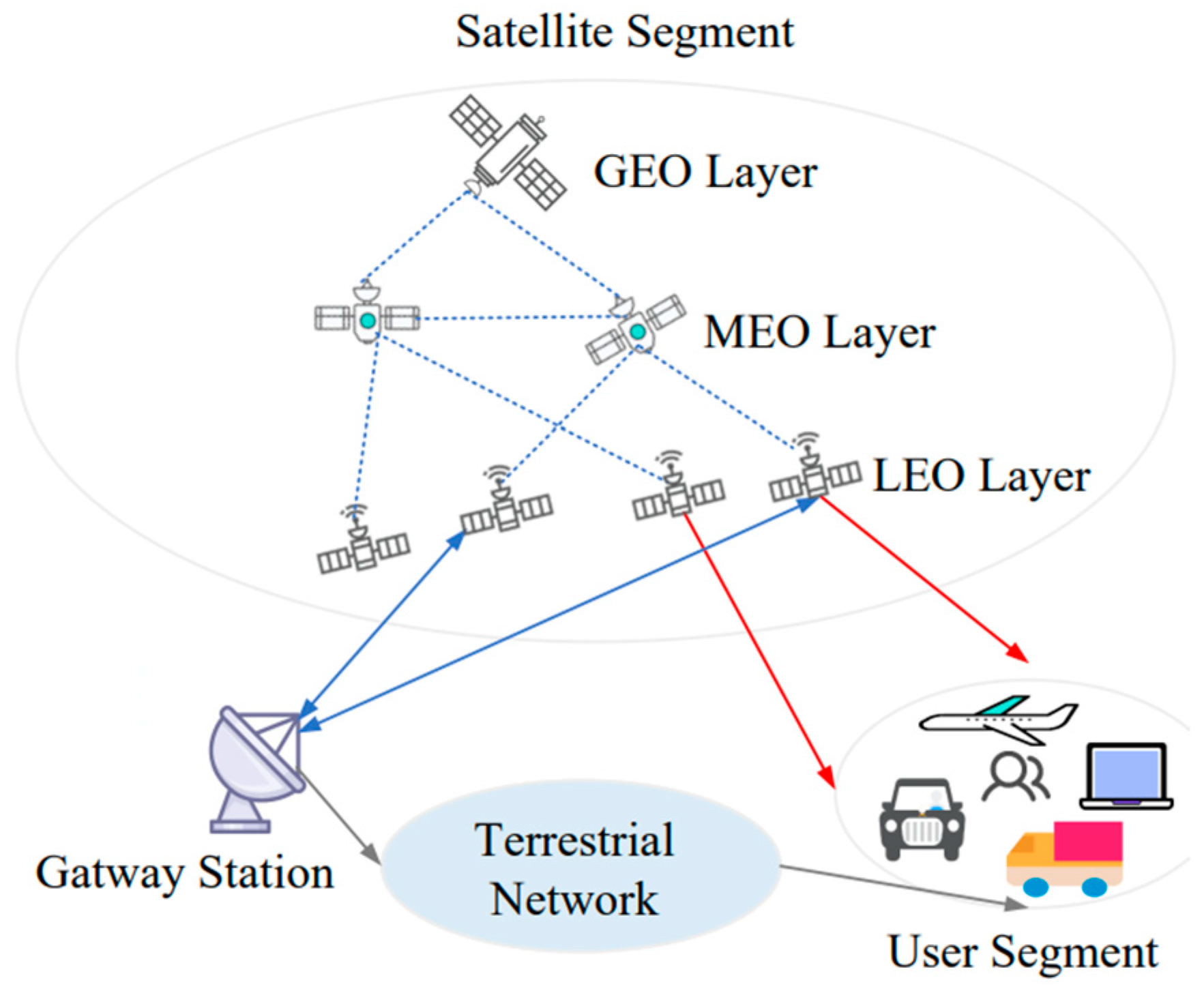
4. Spectrum Sharing and Coexistence
4.1. Coexistence in Radar Networks
4.2. Coexistence in Satellite Communication
4.3. Coexistence in Terrestrial Communication
5. Interference and Mitigation Techniques
6. Challenges, Opportunities, and Limitations of Coexistence
- Interference: Interference remains a primary challenge in wireless communication coexistence [112]. Multiple wireless systems operating within the same frequency band can cause mutual interference, leading to signal degradation and elevated error rates. This can result in poor quality of service, reduced range, and decreased data rates. Interference can occur due to overlapping frequency bands, insufficient separation between systems, and power imbalances [113].
- Network congestion: As the number of wireless communication systems increases, they compete for limited resources such as bandwidth and transmission power, leading to network congestion [114]. This can result in reduced performance, increased latency, and lower throughput. Network congestion can occur due to insufficient capacity, high demand, and inefficient resource allocation.
- Security: With multiple wireless communication systems operating in the same space, there is an increased risk of unauthorized access and security breaches. This can result in data theft, malicious attacks, and network downtime [115]. Security challenges can occur due to weak encryption, insufficient authentication, and vulnerabilities in the wireless communication systems.
- Coexistence standards: The coexistence of multiple wireless communication systems requires the development of coexistence standards to ensure that different systems can effectively operate together. However, the development of these standards can be complex, time-consuming, and costly. This can result in delays in the implementation of new wireless communication systems and reduced innovation [116].
- Frequency resource management: The growing number of wireless communication technologies has intensified the competition for available spectrum resources. Efficient frequency management is required to mitigate spectrum scarcity, but issues such as spectrum fragmentation, inefficient allocation, and regulatory constraints pose significant challenges.
- Energy consumption management: The demand for high-speed, always-on connectivity has led to concerns about energy efficiency in wireless networks. Managing energy consumption, especially in battery-powered devices and infrastructure, is critical; however, existing systems often lack optimized power control mechanisms, resulting in excessive energy use.
- Adaptation to dynamic environments: Wireless networks operate in highly dynamic conditions where factors such as interference levels, user mobility, and environmental changes constantly fluctuate. The inability of current systems to adapt efficiently to these variations leads to network inefficiencies and degraded service quality.
- Spectrum allocation: One of the primary ways to avoid coexistence is to allocate specific frequency bands to different wireless systems. This approach ensures that each wireless system operates in its own frequency band, thereby reducing the likelihood of interference [121]. Governments and regulatory bodies often play a significant role in spectrum allocation, and they allocate frequency bands based on factors such as the type of wireless application, geographical location, and licensing requirements [122].
- Frequency agility: Another opportunity to avoid coexistence is frequency agility, where wireless systems are designed to switch between multiple frequency bands [123]. This approach allows wireless systems to avoid congested frequency bands and operate in less crowded areas, thereby reducing the likelihood of interference. Frequency agility is commonly used in wireless networks such as Wi-Fi, where multiple frequency bands are available for use [124].
- Power control: Wireless systems can employ power control to mitigate interference. This involves dynamically adjusting the transmission power of the devices to avoid disrupting nearby wireless networks [125]. For instance, in cellular networks, base stations regulate their power output based on the mobile device’s distance and signal strength, thereby reducing the potential for interference with neighboring cellular systems [126].
- Antenna design: Antenna design plays a critical role in avoiding coexistence. Antennas can be designed to focus their energy on specific directions, thereby reducing the likelihood of interference with nearby wireless systems. Additionally, antenna diversity techniques such as MIMO (Multiple Input Multiple Output) can be used to improve the reliability of wireless communication by using multiple antennas to transmit and receive signals [127]
- Protocol design: Protocol design is also an essential aspect of avoiding coexistence. Wireless protocols can be designed to detect and avoid interference, such as using collision avoidance techniques to avoid packet collisions in Wi-Fi networks [128]. In addition, protocols can be designed to prioritize critical data and ensure that it is transmitted without interference [129].
7. Conclusions and Future Recommendations
Author Contributions
Funding
Data Availability Statement
Acknowledgments
Conflicts of Interest
Correction Statement
List of Abbreviations
| 5G | 5th—generation |
| NOMA | Non-orthogonal multiple access |
| RAN | Radio access network |
| LAN | Local area network |
| BLE | Bluetooth low energy |
| LoRaWAN | Long range wide area network |
| MIMO | Multiple input multiple output |
| mm | Millimeter |
| GEO | Geostationary orbit |
| MEO | Medium Earth orbit |
| LEO | low Earth orbit |
| FrFT | Fractional Fourier transform |
| IoT | Internet of things |
| CNN | Convolutional neural network |
| FMCW | Frequency modulated continuous wave |
| OFDM | Orthogonal frequency-division multiplexing |
| LFM | Linear frequency modulated |
| EESS | Earth exploration satellite service |
| RLS | Recursive least square |
| FSS | Fixed satellite services |
References
- Smith, L.; Lynch, C.; Kaylor, C.A.; Campos, L.A.; Cheng, L.; Ralph, S.; Tentzeris, M.M. IF2-30 Lens Antenna System Enabling Simplified Designs of 5G/mmW Base Stations and Network Densification. In 2023 IEEE/MTT-S International Microwave Symposium-IMS 2023; IEEE: New York, NY, USA, 2023; pp. 1211–1214. [Google Scholar] [CrossRef]
- Cho, H.; Mukherjee, S.; Kim, D.; Noh, T.; Lee, J. Facing to wireless network densification in 6G: Challenges and opportunities. ICT Express 2023, 9, 517–524. [Google Scholar] [CrossRef]
- Nidhi; Mihovska, A. Small Cell Deployment Challenges in Ultradense Networks: Architecture and Resource Management. In Proceedings of the 12th International Symposium on Communication Systems, Networks and Digital Signal Processing (CSNDSP), Porto, Portugal, 20–22 July 2020; pp. 10–15. [Google Scholar] [CrossRef]
- Parveen, N.; Islam, R.; Abdullah, K.; Boby, R.I. Performance of BER with Different Diversity Techniques for Millimeter-Wave Communication System. Int. J. Innov. Technol. Explor. Eng. 2019, 8, 1149–1152. [Google Scholar] [CrossRef]
- Chiaraviglio, L.; Turco, S.; Bianchi, G.; Blefari-Melazzi, N. “Cellular Network Densification Increases Radio-Frequency Pollution”: True or False? IEEE Trans. Wirel. Commun. 2022, 21, 2608–2622. [Google Scholar] [CrossRef]
- Xu, J.; Rao, Z.; Xu, L.; Yang, D.; Li, T. Incentive Mechanism for Multiple Cooperative Tasks with Compatible Users in Mobile Crowd Sensing via Online Communities. IEEE Trans. Mob. Comput. 2020, 19, 1618–1633. [Google Scholar] [CrossRef]
- Liu, G.; Wang, Z.; Hu, J.; Ding, Z.; Fan, P. Cooperative NOMA Broadcasting/Multicasting for Low-Latency and High-Reliability 5G Cellular V2X Communications. IEEE Internet Things J. 2019, 6, 7828–7838. [Google Scholar] [CrossRef]
- Tan, H.; Liu, Y.; Feng, Z.; Zhang, Q. Coexistence analysis between 5G system and fixed-satellite service in 3400–3600 MHz. China Commun. 2018, 15, 33–50. [Google Scholar] [CrossRef]
- Voicu, A.M.; Simić, L.; Petrova, M. Survey of spectrum sharing for inter-technology coexistence. IEEE Commun. Surv. Tutor. 2018, 21, 1112–1144. [Google Scholar] [CrossRef]
- Zheng, L.; Lops, M.; Eldar, Y.C.; Wang, X. Radar and Communication Coexistence: An Overview: A Review of Recent Methods. IEEE Signal Process. Mag. 2019, 36, 85–99. [Google Scholar] [CrossRef]
- Misra, D.; Misra, D.K.; Tripathi, S.P. Satellite Communication Advancement, Issues, Challenges and Applications. Int. J. Adv. Res. Comput. Commun. Eng. 2013, 2, 1681–1686. [Google Scholar]
- Tai, C.L.; Wu, D. A Review on Coexistence Issues of Broadband Millimeter-Wave Communications. arXiv 2008, arXiv:2008.08916. [Google Scholar]
- Labib, M.; Marojevic, V.; Martone, A.F.; Reed, J.H.; Zaghlour, A.I. Coexistence Between Communications and Radar Systems: A Survey. URSI Radio Sci. Bull. 2017, 2, 74–82. [Google Scholar] [CrossRef]
- Maloku, H.; Fazliu, Z.L.; Ibrani, M. A Survey on Coexistence in Heterogeneous Wireless Networks in TV White Spaces. Wirel. Commun. Mob. Comput. 2018, 2018, 7256835. [Google Scholar] [CrossRef]
- Saadat, M.S.; Sur, S. Enabling Coexistence of Indoor Millimeter- Wave Networking and Human Activity Sensing. In Proceedings of the 2024 IEEE/ACM Conference on Connected Health: Applications, Systems and Engineering Technologies (CHASE), Wilmington, DE, USA, 19–21 June 2024; pp. 37–48. [Google Scholar] [CrossRef]
- Regmi, H.; Sur, S. CoSense: Deep Learning Augmented Sensing for Coexistence with Networking in Millimeter-Wave Picocells. ACM Trans. Internet Things 2024, 5, 1–35. [Google Scholar] [CrossRef]
- Xie, Y.; Liu, D.; Yin, F. Joint Spectrum and Power Allocation with User Association for 5G/Wi-Fi Coexisting Millimeter Wave Networks. Electronics 2023, 12, 959. [Google Scholar] [CrossRef]
- Lim, B.; Vu, M. Interference Analysis for Coexistence of Terrestrial Networks with Satellite Services. IEEE Trans. Wirel. Commun. 2024, 23, 3146–3161. [Google Scholar] [CrossRef]
- Ati, S.B.; Dahrouj, H.; Alouini, M.S. Interference Mitigation in Coexisting Satellites and Cloud-Assisted Ground Networks in the MmWave Band. IEEE Open J. Commun. Soc. 2024, 5, 7483–7497. [Google Scholar] [CrossRef]
- Hassan, Z.; Heeren-Moon, E.; Sabzehali, J.; Shah, V.K.; Dietrich, C.; Reed, J.H.; Burger, E.W. Spectrum Sharing of the 12 GHz Band with Two-Way Terrestrial 5G Mobile Services: Motivations, Challenges, and Research Road Map. IEEE Commun. Mag. 2023, 61, 53–59. [Google Scholar] [CrossRef]
- Vosoughitabar, S.; Mandayam, N.B.; Brodie, J.F.; Golparvar, B.; Wang, R.Q.; Wu, C.T.M. Design of a Reconfigurable Filtenna with Constant Bandwidth for Enhanced 5G mmWave Communication and Spectrum Coexistence. In Proceedings of the 2024 IEEE International Symposium on Dynamic Spectrum Access Networks (DySPAN), Washington, DC, USA, 13–16 May 2024; pp. 517–523. [Google Scholar] [CrossRef]
- Xie, Y.; Liu, D.; Zhang, Z. Joint Beam and Spectrum Allocation with User Association for 5G/WiFi Coexisting Millimeter Wave Networks. Lect. Notes Electr. Eng. 2024, 1033, 59–67. [Google Scholar] [CrossRef]
- Aboagye, S.; Saeidi, M.A.; Tabassum, H.; Tayyar, Y.; Hossain, E.; Yang, H.C.; Alouini, M.S. Multi-Band Wireless Communication Networks: Fundamentals, Challenges, and Resource Allocation. IEEE Trans. Commun. 2024, 72, 4333–4383. [Google Scholar] [CrossRef]
- Parveen, N.; Abdullah, K.; Badron, K.; Diyana, F.; Rahman, A.; Morshidi, A. Bin Generation and Analysis of 5G Downlink Signal. J. Adv. Res. Appl. Sci. Eng. Technol. 2022, 1, 23–30. [Google Scholar]
- Zhang, R.; Zhang, L.; Yue, Y.; Feng, H.; Li, Z.; Ying, D. Editorial for Special Issue “Advancements in Wireless Communications, Networks, and Signal Processing”. Appl. Sci. 2024, 14, 5725. [Google Scholar] [CrossRef]
- Soh, Y.S.; Quek, T.Q.S.; Kountouris, M.; Shin, H. Energy efficient heterogeneous cellular networks. IEEE J. Sel. Areas Commun. 2013, 31, 840–850. [Google Scholar] [CrossRef]
- Andrews, J.G.; Baccelli, F.; Ganti, R.K. A tractable approach to coverage and rate in cellular networks. IEEE Trans. Commun. 2011, 59, 3122–3134. [Google Scholar] [CrossRef]
- Hasan, Z.; Boostanimehr, H.; Bhargava, V.K. Green cellular networks: A survey, some research issues and challenges. IEEE Commun. Surv. Tutor. 2011, 13, 524–540. [Google Scholar] [CrossRef]
- Ge, X.; Tu, S.; Mao, G.; Wang, C.X.; Han, T. 5G Ultra-Dense Cellular Networks. IEEE Wirel. Commun. 2016, 23, 72–79. [Google Scholar] [CrossRef]
- Ghosh, A.; Mangalvedhe, N.; Ratasuk, R.; Mondal, B.; Cudak, M.; Visotsky, E.; Thomas, T.A.; Andrews, J.G.; Xia, P.; Jo, H.S.; et al. Heterogeneous cellular networks: From theory to practice. IEEE Commun. Mag. 2012, 50, 54–64. [Google Scholar] [CrossRef]
- Brunello, A.; Dalla Torre, A.; Gallo, P.; Gubiani, D.; Montanari, A.; Saccomanno, N. Crowdsourced Reconstruction of Cellular Networks to Serve Outdoor Positioning: Modeling, Validation and Analysis. Sensors 2023, 23, 352. [Google Scholar] [CrossRef]
- Afanasyev, M.; Chen, T.; Voelker, G.M.; Snoeren, A.C. Usage patterns in an urban WiFi network. IEEE/ACM Trans. Netw. 2010, 18, 1359–1372. [Google Scholar] [CrossRef]
- Dimatteo, S.; Hui, P.; Han, B.; Li, V.O.K. Cellular traffic offloading through WiFi networks. In Proceedings of the 8th IEEE International Conference on Mobile Ad-hoc and Sensor Systems, Valencia, Spain, 17–21 October 2011; pp. 192–201. [Google Scholar] [CrossRef]
- Zhong, Z.; Kulkarni, P.; Cao, F.; Fan, Z.; Armour, S. Issues and challenges in dense WiFi networks. In Proceedings of the IWCMC 2015—11th International Wireless Communications and Mobile Computing Conference, Leeds, UK, 24–28 August 2015; pp. 947–951. [Google Scholar] [CrossRef]
- Duarte, M.; Sabharwal, A.; Aggarwal, V.; Jana, R.; Ramakrishnan, K.K.; Rice, C.W.; Shankaranarayanan, N.K. Design and characterization of a full-duplex multiantenna system for wifi networks. IEEE Trans. Veh. Technol. 2014, 63, 1160–1177. [Google Scholar] [CrossRef]
- Wu, X.; Soltani, M.D.; Zhou, L.; Safari, M.; Haas, H. Hybrid LiFi and WiFi Networks: A Survey. IEEE Commun. Surv. Tutor. 2021, 23, 1398–1420. [Google Scholar] [CrossRef]
- Roy, S.C.; Funabiki, N.; Rahman, M.M.; Wu, B.; Kuribayashi, M.; Kao, W.C. A Study of the Active Access-Point Configuration Algorithm under Channel Bonding to Dual IEEE 802.11n and 11ac Interfaces in an Elastic WLAN System for IoT Applications. Signals 2023, 4, 274–296. [Google Scholar] [CrossRef]
- Bello, L.L.; Mirabella, O. Communication Techniques and Architectures for Bluetooth Networks in Industrial Scenarios. In Proceedings of the IEEE Conference on Emerging Technologies and Factory Automation, Catania, Italy, 19–22 September 2005; Volume 1, pp. 53–61. [Google Scholar]
- Raza, S.; Misra, P.; He, Z.; Voigt, T. Bluetooth smart: An enabling technology for the Internet of Things. In Proceedings of the 2015 IEEE 11th International Conference on Wireless and Mobile Computing, Networking and Communications (WiMob), Abu Dhabi, United Arab Emirates, 19–21 October 2015; pp. 155–162. [Google Scholar] [CrossRef]
- Nair, K.; Kulkarni, J.; Warde, M.; Dave, Z.; Rawalgaonkar, V.; Gore, G.; Joshi, J. Optimizing power consumption in iot based wireless sensor networks using Bluetooth Low Energy. In Proceedings of the 2015 International Conference on Green Computing and Internet of Things, ICGCIoT 2015, Delhi, India, 8–10 October 2015; pp. 589–593. [Google Scholar] [CrossRef]
- Darroudi, S.M.; Gomez, C.; Crowcroft, J. Bluetooth Low Energy Mesh Networks: A Standards Perspective. IEEE Commun. Mag. 2020, 58, 95–101. [Google Scholar] [CrossRef]
- Jung, C.; Kim, K.; Seo, J.; Silva, B.N.; Han, K. Topology Configuration and Multihop Routing Protocol for Bluetooth Low Energy Networks. IEEE Access 2017, 5, 9587–9598. [Google Scholar] [CrossRef]
- Kumar, T.; Mane, P.B. ZigBee topology: A survey. In Proceedings of the 2016 International Conference on Control, Instrumentation, Communication and Computational Technologies (ICCICCT), Kumaracoil, India, 16–17 December 2016; pp. 164–166. [Google Scholar] [CrossRef]
- Pan, G.; He, J.; Wu, Q.; Fang, R.; Cao, J.; Liao, D. Automatic stabilization of Zigbee network. In Proceedings of the 2018 International Conference on Artificial Intelligence and Big Data (ICAIBD 2018), Chengdu, China, 26–28 May 2018; pp. 224–227. [Google Scholar] [CrossRef]
- Cao, X.; Shila, D.M.; Cheng, Y.; Yang, Z.; Zhou, Y.; Chen, J. Ghost-in-ZigBee: Energy Depletion Attack on ZigBee-Based Wireless Networks. IEEE Internet Things J. 2016, 3, 816–829. [Google Scholar] [CrossRef]
- Lalle, Y.; Fourati, L.C.; Fourati, M.; Barraca, J.P. A Comparative Study of LoRaWAN, SigFox, and NB-IoT for Smart Water Grid. In Proceedings of the Global Information Infrastructure and Networking Symposium, Pairs, France, 18–20 December 2019; pp. 1–6. [Google Scholar] [CrossRef]
- Unwala, I.; Taqvi, Z.; Lu, J. IoT security: ZWave and thread. In Proceedings of the 2018 IEEE Green Technologies Conference (GreenTech), Austin, TX, USA, 4–6 April 2018; pp. 176–182. [Google Scholar] [CrossRef]
- Di, B.; Zhang, H.; Song, L.; Li, Y.; Li, G.Y. Ultra-Dense LEO: Integrating Terrestrial-Satellite Networks into 5G and beyond for Data Offloading. IEEE Trans. Wirel. Commun. 2019, 18, 47–62. [Google Scholar] [CrossRef]
- Bertaux, L.; Medjiah, S.; Berthou, P.; Abdellatif, S.; Hakiri, A.; Gelard, P.; Planchou, F.; Bruyere, M. Software defined networking and virtualization for broadband satellite networks. IEEE Commun. Mag. 2015, 53, 54–60. [Google Scholar] [CrossRef]
- Zhu, X.; Jiang, C.; Kuang, L.; Ge, N.; Lu, J. Non-Orthogonal Multiple Access Based Integrated Terrestrial-Satellite Networks. IEEE J. Sel. Areas Commun. 2017, 35, 2253–2267. [Google Scholar] [CrossRef]
- Al-Hourani, A. Session Duration between Handovers in Dense LEO Satellite Networks. IEEE Wirel. Commun. Lett. 2021, 10, 2810–2814. [Google Scholar] [CrossRef]
- Baba, T.; Ahmed Siddiqui, N.; Bte Saidin, N.; Md Yusoff, S.H.; Abdul Sani, S.F.B.; Abdul Karim, J.; Hasbullah, N.F. Radiation-induced degradation of silicon carbide MOSFETs—A review. Mater. Sci. Eng. B 2024, 300, 117096. [Google Scholar] [CrossRef]
- Cao, X.; Li, Y.; Xiong, X.; Wang, J. Dynamic Routings in Satellite Networks: An Overview. Sensors 2022, 22, 4552. [Google Scholar] [CrossRef]
- Parveen, N.; Abdullah, K.; Islam, R.; Boby, R.I. Performance of MIMO DWT for Millimeter Wave Communication System. In Proceedings of the 2019 IEEE 14th Malaysia International Conference on Communication (MICC), Selangor, Malaysia, 2–4 December 2019; pp. 2–4. [Google Scholar]
- Munir, M.E.; Al Harbi, A.G.; Kiani, S.H.; Marey, M.; Parchin, N.O.; Khan, J.; Mostafa, H.; Iqbal, J.; Khan, M.A.; See, C.H.; et al. A New mm-Wave Antenna Array with Wideband Characteristics for Next Generation Communication Systems. Electronics 2022, 11, 1560. [Google Scholar] [CrossRef]
- Sharma, S.K.; Bogale, T.E.; Le, L.B.; Chatzinotas, S.; Wang, X.; Ottersten, B. Dynamic Spectrum Sharing in 5G Wireless Networks with Full-Duplex Technology: Recent Advances and Research Challenges. IEEE Commun. Surv. Tutor. 2018, 20, 674–707. [Google Scholar] [CrossRef]
- Lee, H.W.; Medles, A.; Jie, V.; Lin, D.; Zhu, X.C.; Fu, I.K.; Wei, H.Y. Reverse Spectrum Allocation for Spectrum Sharing between TN and NTN. In Proceedings of the 2021 IEEE Conference on Standards for Communications and Networking (CSCN), Thessaloniki, Greece, 15–17 December 2021. [Google Scholar]
- Gottinger, M.; Hoffmann, M.; Christmann, M.; Schutz, M.; Kirsch, F.; Gulden, P.; Vossiek, M. Coherent Automotive Radar Networks: The Next Generation of Radar-Based Imaging and Mapping. IEEE J. Microw. 2021, 1, 149–163. [Google Scholar] [CrossRef]
- Rock, J.; Roth, W.; Meissner, P.; Pernkopf, F. Quantized Neural Networks for Radar Interference Mitigation. arXiv 2020, arXiv:2011.12706. [Google Scholar]
- Rock, J.; Roth, W.; Toth, M.; Meissner, P.; Pernkopf, F. Resource-Efficient Deep Neural Networks for Automotive Radar Interference Mitigation. IEEE J. Sel. Top. Signal Process. 2021, 15, 927–940. [Google Scholar] [CrossRef]
- Shaikh, I.M.; Akhtar, M.N.; Aabid, A.; Ahmed, O.S. Enhancing sustainability in the production of palm oil: Creative monitoring methods using YOLOv7 and YOLOv8 for effective plantation management. Biotechnol. Rep. 2024, 44, e00853. [Google Scholar] [CrossRef]
- Alaskar, H.; Saba, T. Machine Learning and Deep Learning: A Comparative Review. In Proceedings of Integrated Intelligence Enable Networks and Computing; Springer: Berlin/Heidelberg, Germany, 2021; pp. 143–150. [Google Scholar]
- Mert Sahin, M.; Arslan, H. Multi-functional Coexistence of Radar-Sensing and Communication Waveforms. In Proceedings of the 2020 IEEE 92nd Vehicular Technology Conference (VTC2020-Fall), Victoria, BC, Canada, 18 November–16 December 2020; pp. 1–5. [Google Scholar] [CrossRef]
- Buzzi, S.; Lops, M.; D’Andrea, C.; Delia, C. Co-Existence between a Radar System and a Massive MIMO Wireless Cellular System. In Proceedings of the 2018 IEEE 19th International Workshop on Signal Processing Advances in Wireless Communications (SPAWC), Kalamata, Greece, 25–28 June 2018. [Google Scholar] [CrossRef]
- Gaglione, D.; Clemente, C.; Ilioudis, C.V.; Persico, A.R.; Proudler, I.K.; Soraghan, J.J. Fractional fourier based waveform for a joint radar-communication system. In Proceedings of the 2016 IEEE Radar Conference (RadarConf), Philadelphia, PA, USA, 2–6 May 2016. [Google Scholar] [CrossRef]
- Liu, F.; Masouros, C.; Li, A.; Ratnarajah, T.; Zhou, J. MIMO Radar and cellular coexistence: A power-efficient approach enabled by interference exploitation. IEEE Trans. Signal Process. 2018, 66, 3681–3695. [Google Scholar] [CrossRef]
- Di, B.; Song, L.; Li, Y.; Poor, H.V. Ultra-Dense LEO: Integration of satellite access networks into 5G and beyond. IEEE Wirel. Commun. 2019, 26, 62–69. [Google Scholar] [CrossRef]
- Wang, Y.; Yang, J.; Guo, X.; Qu, Z. A Game-Theoretic Approach to Computation Offloading in Satellite Edge Computing. IEEE Access 2020, 8, 12510–12520. [Google Scholar] [CrossRef]
- Centenaro, M.; Costa, C.E.; Granelli, F.; Sacchi, C.; Vangelista, L. A survey on technologies, standards and open challenges in satellite IoT. IEEE Commun. Surv. Tutor. 2021, 23, 1693–1720. [Google Scholar] [CrossRef]
- Lagunas, E.; Tsinos, C.G.; Sharma, S.K.; Chatzinotas, S. 5G cellular and fixed satellite service spectrum coexistence in C-band. IEEE Access 2020, 8, 72078–72094. [Google Scholar] [CrossRef]
- Cho, Y.; Kim, H.-K.; Nekovee, M.; Jo, H.-S. Coexistence of 5G With Satellite Services in the Millimeter-Wave Band. IEEE Access 2020, 8, 163618–163636. [Google Scholar] [CrossRef]
- Muhammad, C.B.; Anwar, K. Interference Mitigation using Adaptive Beamforming with RLS Algorithm for Coexistence between 5G and Fixed Satellite Services in C-Band. J. Phys. Conf. Ser. 2020, 1577, 012029. [Google Scholar] [CrossRef]
- Habibi, M.A.; Nasimi, M.; Han, B.; Schotten, H.D. A Comprehensive Survey of RAN Architectures Toward 5G Mobile Communication System. IEEE Access 2019, 7, 70371–70421. [Google Scholar] [CrossRef]
- Logeshwaran, J.; Selvaraj, K. A Smart Design of a Multi-Dimensional Antenna to Enhance the Maximum Signal Clutch to the Allowable Standards in 5G Communication Networks. J. Microelectron. 2022, 8, 1269–1274. [Google Scholar] [CrossRef]
- Yang, M.; Grace, D. Interaction and coexistence of multicast terrestrial communication systems with area optimized channel assignments. In Proceedings of the 2008 Third International Conference on Communications and Networking in China, Hangzhou, China, 25–27 August 2008; pp. 1292–1296. [Google Scholar] [CrossRef]
- Liang, Y.; Tan, J.; Jia, H.; Zhang, J.; Zhao, L. Realizing Intelligent Spectrum Management for Integrated Satellite and Terrestrial Networks. J. Commun. Inf. Netw. 2021, 6, 32–43. [Google Scholar]
- Noh, G.; Chung, H.; Kim, I. Outage Analysis for Terrestrial-Satellite Spectrum Sharing. IEEE Commun. Lett. 2020, 24, 2280–2284. [Google Scholar] [CrossRef]
- Yan, Y.; An, K.; Zhang, B.; Zhu, W.; Ding, G.; Guo, D. Outage-Constrained Robust Multigroup Multicast Beamforming for Satellite-Based Internet of Things Coexisting with Terrestrial Networks. IEEE Internet Things J. 2021, 8, 8159–8172. [Google Scholar]
- Guidolin, F.; Nekovee, M.; Badia, L.; Zorzi, M. A study on the coexistence of fixed satellite service and cellular networks in a mmWave scenario. In Proceedings of the 2015 IEEE International Conference on Communications (ICC), London, UK, 8–12 September 2015; pp. 2444–2449. [Google Scholar] [CrossRef]
- Castellanos, G.; Teuta, G. Coexistence for LTE-Advanced and FSS Services in the 3.5 GHz Band in Colombia. In Proceedings of the 10th Advanced Satellite Multimedia Systems Conference and the 16th Signal Processing for Space Communications Workshop (ASMS/SPSC), Graz, Austria, 20–21 October 2020. [Google Scholar]
- Meng, X.; Zhong, L.; Zhou, D.; Yang, D. Co-channel coexistence analysis between 5G iot system and fixed-satellite service at 40 GHz. Wirel. Commun. Mob. Comput. 2019, 2019, 9790219. [Google Scholar] [CrossRef]
- Hassan, W.A.; Jo, H.S.; Tharek, A.R. The Feasibility of Coexistence between 5G and Existing Services in the IMT-2020 Candidate Bands in Malaysia. IEEE Access 2017, 5, 14867–14888. [Google Scholar] [CrossRef]
- Alexandre, L.; Veiga, L.; Linhares, A.; Moreira, J.; Abreu, M.; Sodré Junior, A. Coexistence Analysis Between 5G NR and TVRO in C-Band. J. Commun. Inf. Syst. 2020, 35, 198–202. [Google Scholar] [CrossRef]
- Hattab, G.; Moorut, P.; Visotsky, E.; Cudak, M.; Ghosh, A. Interference analysis of the coexistence of 5G cellular networks with satellite earth stations in 3.7–4.2 GHz. In Proceedings of the 2018 IEEE International Conference on Communications Workshops (ICC Workshops), Kansas City, MO, USA, 20–24 May 2018. [Google Scholar] [CrossRef]
- Qian, J.; Liu, R.; Huang, Y.; Luo, Y.; Huang, Y.; Tian, F. MIMO Radar and MIMO Communication Spectrum Sharing with Interference Mitigation. In Proceedings of the 2019 IEEE 2nd International Conference on Electronic Information and Communication Technology (ICEICT), Harbin, China, 20–22 January 2019; Volume 1, pp. 562–567. [Google Scholar] [CrossRef]
- Alland, S.; Stark, W.; Ali, M.; Hegde, M. Interference in Automotive Radar Systems. IEEE Signal Process. Mag. 2019, 36, 45–59. [Google Scholar]
- Rock, J.; Toth, M.; Meissner, P.; Pernkopf, F. Deep interference mitigation and denoising of real-world FMCW radar signals. In Proceedings of the 2020 IEEE International Radar Conference (RADAR), Florence, Italy, 28–30 April 2020; pp. 624–629. [Google Scholar] [CrossRef]
- Azari, M.M.; Rosas, F.; Chiumento, A.; Pollin, S. Coexistence of Terrestrial and Aerial Users in Cellular Networks. In Proceedings of the 2017 IEEE Globecom Workshops (GC Wkshps), Singapore, 4–8 December 2018; pp. 1–6. [Google Scholar] [CrossRef]
- Yrjola, S.; Huuhka, E.; Talmola, P.; Knuutila, T. Coexistence of Digital Terrestrial Television and 4G LTE Mobile Network Utilizing Supplemental Downlink Concept: A Real Case Study. IEEE Trans. Veh. Technol. 2017, 66, 5422–5434. [Google Scholar] [CrossRef]
- Rudd, R. Coexistence of Terrestrial and Satellite services at 26 GHz. IEEE Trans. Aerosp. Electron. Syst. 2019, 59, 8342–8354. [Google Scholar]
- Lagunas, E.; Sharma, S.K.; Maleki, S.; Chatzinotas, S.; Ottersten, B. Resource Allocation for Cognitive Satellite Communications with Incumbent Terrestrial Networks. IEEE Trans. Cogn. Commun. Netw. 2015, 1, 305–317. [Google Scholar] [CrossRef]
- Polak, L.; Klozar, L.; Kaller, O.; Sebesta, J.; Slanina, M.; Kratochvil, T. Study of coexistence between indoor LTE femtocell and outdoor-to-indoor DVB-T2-Lite reception in a shared frequency band. Eurasip J. Wirel. Commun. Netw. 2015, 2015, 114. [Google Scholar] [CrossRef][Green Version]
- Joshi, S.; Mallik, R.K. Coverage Probability Analysis in a Device-to-Device Network: Interference Functional and Laplace Transform Based Approach. IEEE Commun. Lett. 2019, 23, 466–469. [Google Scholar] [CrossRef]
- Parveen, N.; Abdullah, K.; Islam, M.R.; Abbasi, M.A.K. Performance Analysis Antenna Diversity Technique with Wavelet Transform Using Array Gain for Millimeter Wave Communication System. Electronics 2022, 11, 2626. [Google Scholar] [CrossRef]
- Ahmad, I.; Hussain, S.; Mahmood, S.N.; Mostafa, H.; Alkhayyat, A.; Marey, M.; Abbas, A.H.; Abdulateef Rashed, Z. Co-Channel Interference Management for Heterogeneous Networks Using Deep Learning Approach. Information 2023, 14, 139. [Google Scholar] [CrossRef]
- Wang, W.; Qi, N.; Jia, L.; Li, C.; Tsiftsis, T.A.; Wang, M. Energy-Efficient UAV-Relaying 5G/6G Spectrum Sharing Networks: Interference Coordination with Power Management and Trajectory Design. IEEE Open J. Commun. Soc. 2022, 3, 1672–1687. [Google Scholar] [CrossRef]
- Kim, H.; Kim, J.; Hong, D. Dynamic TDD Systems for 5G and Beyond: A Survey of Cross-Link Interference Mitigation. IEEE Commun. Surv. Tutor. 2020, 22, 2315–2348. [Google Scholar] [CrossRef]
- Aydogdu, C.; Keskin, M.F.; Garcia, N.; Wymeersch, H.; Bliss, D.W. RadChat: Spectrum Sharing for Automotive Radar Interference Mitigation. IEEE Trans. Intell. Transp. Syst. 2021, 22, 416–429. [Google Scholar] [CrossRef]
- Pang, X.; Mei, W.; Zhao, N.; Zhang, R. Intelligent Reflecting Surface Assisted Interference Mitigation for Cellular-Connected UAV. IEEE Wirel. Commun. Lett. 2022, 11, 1708–1712. [Google Scholar] [CrossRef]
- Baig, M.U.; Host-Madsen, A.; Nosratinia, A. Discrete Modulation for Interference Mitigation. IEEE Trans. Inf. Theory 2020, 66, 3026–3039. [Google Scholar] [CrossRef]
- Ayoughi, S.A.; Yu, W. Interference mitigation via relaying. IEEE Trans. Inf. Theory 2019, 65, 1137–1152. [Google Scholar] [CrossRef]
- Baba, T.; Mustapha, N.A.C.; Hasbullah, N.F. A review on techniques and modelling methodologies used for checking electromagnetic interference in integrated circuits. Indones. J. Electr. Eng. Comput. Sci. 2022, 25, 796–804. [Google Scholar] [CrossRef]
- Batra, A.; Zeidler, J.R. Narrowband interference mitigation in OFDM systems. In Proceedings of the MILCOM 2008—2008 IEEE Military Communications Conference, San Diego, CA, USA, 16–19 November 2008. [Google Scholar] [CrossRef]
- Saha, R.K. On Developing Techniques for Sharing Satellite Spectrum with Indoor Small Cells in 5G. Energies 2020, 13, 748. [Google Scholar] [CrossRef]
- Sarowa, S.; Singh, H.; Agrawal, S.; Sohi, B.S. Design of a novel hybrid intercarrier interference mitigation technique through wavelet implication in an OFDM system. Digit. Commun. Netw. 2018, 4, 258–263. [Google Scholar] [CrossRef]
- Lim, J.W.; Jo, H.S.; Yoon, H.G.; Yook, J.G. Interference mitigation technique for the sharing between IMT-advanced and fixed satellite service. J. Commun. Netw. 2007, 9, 159–166. [Google Scholar] [CrossRef]
- Jo, S.; Yang, W.; Choi, H.K.; Noh, E.; Jo, H.S.; Park, J. Deep Q-Learning-Based Transmission Power Control of a High Altitude Platform Station with Spectrum Sharing. Sensors 2022, 22, 1630. [Google Scholar] [CrossRef]
- Ye, N.; Miao, S.; Pan, J.; Xiang, Y.; Mumtaz, S. Dancing with Chains: Spaceborne Distributed Multi-User Detection under Inter-Satellite Link Constraints. IEEE J. Sel. Top. Signal Process. 2025, 19, 430–446. [Google Scholar] [CrossRef]
- Yang, J.; Zhang, Y.; Zhang, D.; Hong, T.; Liu, Q.; Sun, D.; Dong, A.; Lv, S. Highly Selective Filter for Suppressing Interference of 5G Signals to C-band Satellite Receiver. In Proceedings of the 2020 International Wireless Communications and Mobile Computing (IWCMC), Limassol, Cyprus, 15–19 June 2020; pp. 24–27. [Google Scholar] [CrossRef]
- Soltanaghai, E. Perceiving the World with Pervasive Wireless Communication Infrastructures. In Proceedings of the 2022 14th International Conference on Communication Systems & NETworkS (COMSNETS), Bangalore, India, 4–8 January 2022; pp. 558–564. [Google Scholar] [CrossRef]
- Uzunidis, D.; Kosmatos, E.; Matrakidis, C.; Stavdas, A.; Lord, A.; Uzunidis, D. Strategies for Upgrading an Operator’s Backbone Network beyond the C-Band: Towards Multi-Band Optical Networks. IEEE Photonics J. 2021, 13, 7200118. [Google Scholar] [CrossRef]
- O’Mahony, G.D.; Curran, J.T.; Harris, P.J.; Murphy, C.C. Interference and intrusion in wireless sensor networks. IEEE Aerosp. Electron. Syst. Mag. 2020, 35, 4–16. [Google Scholar] [CrossRef]
- Hweesa, N.L.M.; Zerek, A.R.; Daeri, A.M. Investigation the Performance Effect of Adjacent and Co-Channel Interferences on AWGN and Rayleigh Channels Using16-QAM Modulation. In Proceedings of the 2020 17th International Multi-Conference on Systems, Signals & Devices (SSD), Sfax, Tunisia, 20–23 July 2020; pp. 1052–1057. [Google Scholar] [CrossRef]
- Hu, J.; Wu, J.; Ai, X.; Liu, N. Coordinated Energy Management of Prosumers in a Distribution System Considering Network Congestion. IEEE Trans. Smart Grid 2021, 12, 468–478. [Google Scholar] [CrossRef]
- Feng, M.; Xu, H. MSNET-Blockchain: A New Framework for Securing Mobile Satellite Communication Network. In Proceedings of the 2019 16th Annual IEEE International Conference on Sensing, Communication, and Networking (SECON), Boston, MA, USA, 10–13 June 2019; pp. 1–9. [Google Scholar] [CrossRef]
- Kassab, R.; Munari, A.; Clazzer, F.; Simeone, O. Grant-Free Coexistence of Critical and Noncritical IoT Services in Two-Hop Satellite and Terrestrial Networks. IEEE Internet Things J. 2022, 9, 14829–14843. [Google Scholar] [CrossRef]
- Angueira, P.; Val, I.; Montalban, J.; Seijo, O.; Iradier, E.; Fontaneda, P.S.; Fanari, L.; Arriola, A. A Survey of Physical Layer Techniques for Secure Wireless Communications in Industry. IEEE Commun. Surv. Tutor. 2022, 24, 810–838. [Google Scholar] [CrossRef]
- Chen, S.; Sun, S.; Kang, S. System integration of terrestrial mobile communication and satellite communication-The trends, challenges and key technologies in B5G and 6G. China Commun. 2020, 17, 156–171. [Google Scholar] [CrossRef]
- Yuan, X.; Zhang, Y.J.A.; Shi, Y.; Yan, W.; Liu, H. Reconfigurable-Intelligent-Surface Empowered Wireless Communications: Challenges and Opportunities. IEEE Wirel. Commun. 2021, 28, 136–143. [Google Scholar] [CrossRef]
- Niknam, S.; Dhillon, H.S.; Reed, J.H. Federated Learning for Wireless Communications: Motivation, Opportunities, and Challenges. IEEE Commun. Mag. 2020, 58, 46–51. [Google Scholar] [CrossRef]
- Chen, J.; Wu, Q.; Xu, Y.; Qi, N.; Fang, T.; Liu, D. Spectrum Allocation for Task-Driven UAV Communication Networks Exploiting Game Theory. IEEE Wirel. Commun. 2021, 28, 174–181. [Google Scholar] [CrossRef]
- Chen, J.; Wu, Q.; Xu, Y.; Qi, N.; Guan, X.; Zhang, Y.; Xue, Z. Joint Task Assignment and Spectrum Allocation in Heterogeneous UAV Communication Networks: A Coalition Formation Game-Theoretic Approach. IEEE Trans. Wirel. Commun. 2021, 20, 440–452. [Google Scholar] [CrossRef]
- Omar, A.R.S.; Qwakneh, M.M.; Alhammami, K.A.; Faouri, Y.S. Triple Split Ring Resonators Metamaterial for Frequency Agility. In Proceedings of the 2020 IEEE 5th International Symposium on Telecommunication Technologies (ISTT), Shah Alam, Malaysia, 9–11 November 2020; pp. 61–64. [Google Scholar] [CrossRef]
- Zhang, Y.; Zhao, Z.; Zheng, S.; Qiang, F. Intelligent Anti-Jamming decision with Continuous Action and State in Bivariate Frequency Agility Communication System. IEEE Trans. Cogn. Commun. Netw. 2023, 9, 1579–1595. [Google Scholar] [CrossRef]
- Zhang, H.; Yang, N.; Huangfu, W.; Long, K.; Leung, V.C.M. Power Control Based on Deep Reinforcement Learning for Spectrum Sharing. IEEE Trans. Wirel. Commun. 2020, 19, 4209–4219. [Google Scholar] [CrossRef]
- Zhang, T.; Mao, S. Energy-Efficient Power Control in Wireless Networks with Spatial Deep Neural Networks. IEEE Trans. Cogn. Commun. Netw. 2020, 6, 111–124. [Google Scholar] [CrossRef]
- Dai, L.; Renzo, M.D.; Chae, C.B.; Hanzo, L.; Wang, B.; Wang, M.; Yang, X.; Tan, J.; Bi, S.; Xu, S.; et al. Reconfigurable Intelligent Surface-Based Wireless Communications: Antenna Design, Prototyping, and Experimental Results. IEEE Access 2020, 8, 45913–45923. [Google Scholar] [CrossRef]
- Hu, J.; Zhang, H.; Song, L.; Han, Z.; Poor, H.V. Reinforcement Learning for a Cellular Internet of UAVs: Protocol Design, Trajectory Control, and Resource Management. IEEE Wirel. Commun. 2020, 27, 116–123. [Google Scholar] [CrossRef]
- Yang, Y.; Zheng, B.; Zhang, S.; Zhang, R. Intelligent Reflecting Surface Meets OFDM: Protocol Design and Rate Maximization. IEEE Trans. Commun. 2020, 68, 4522–4535. [Google Scholar] [CrossRef]
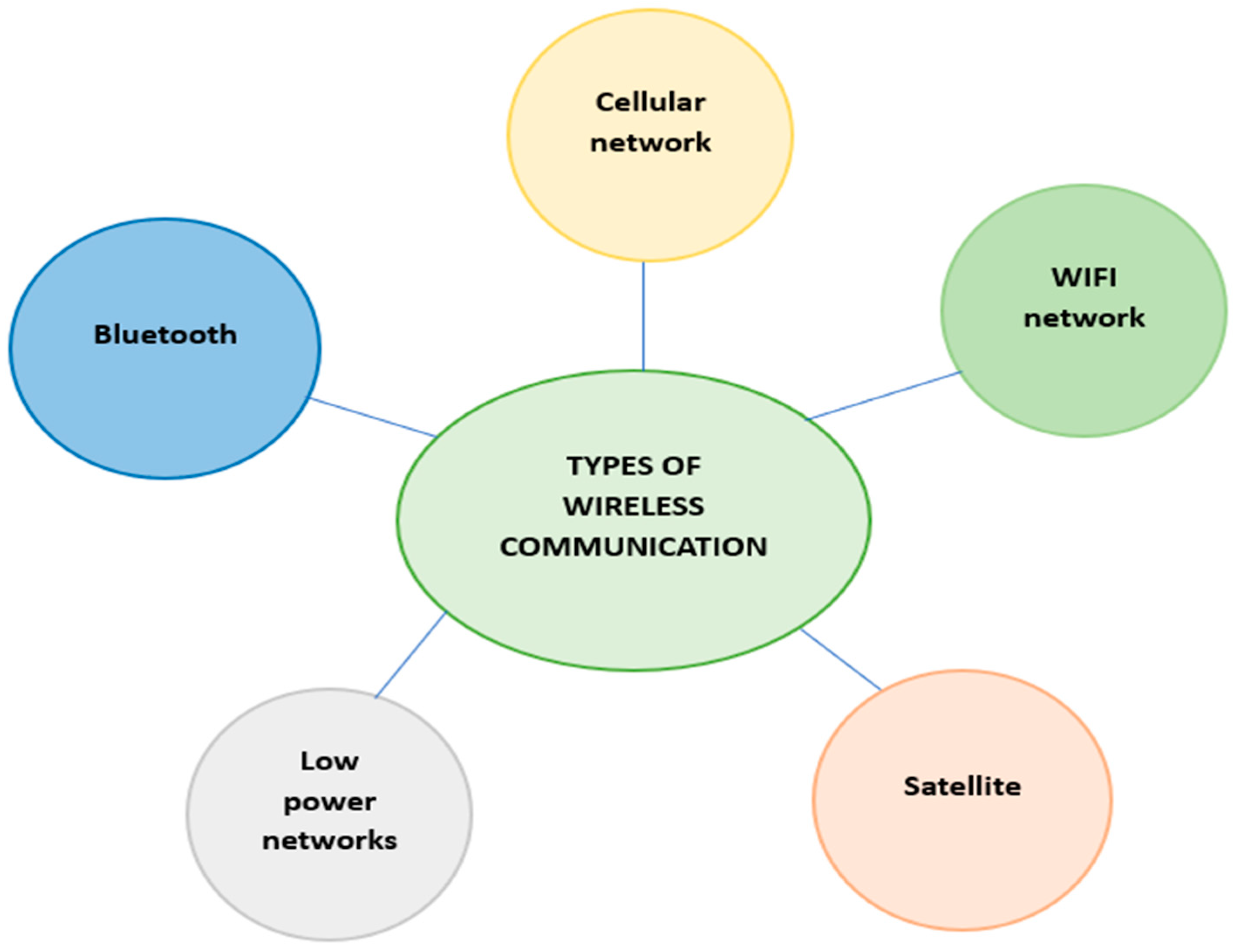

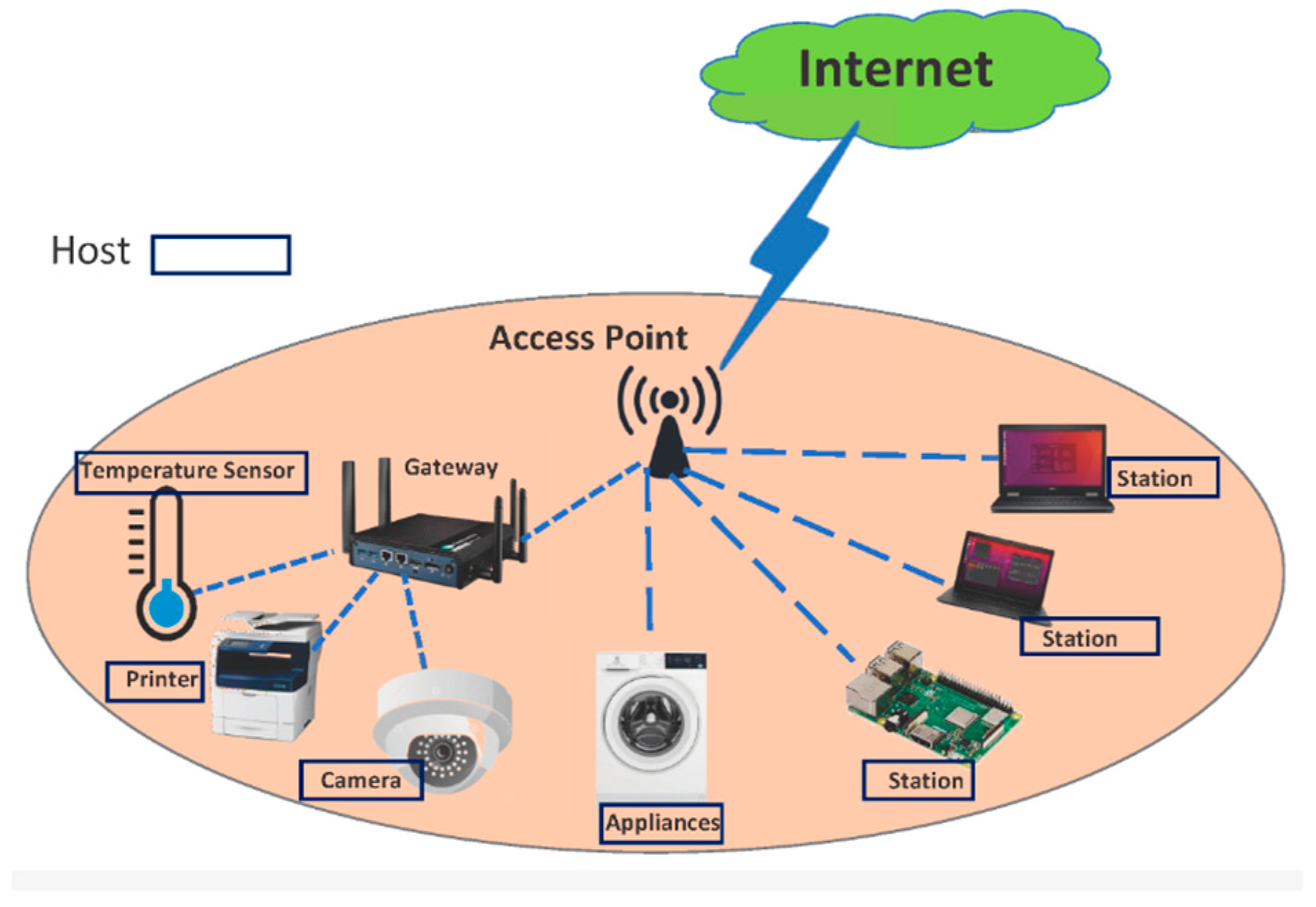

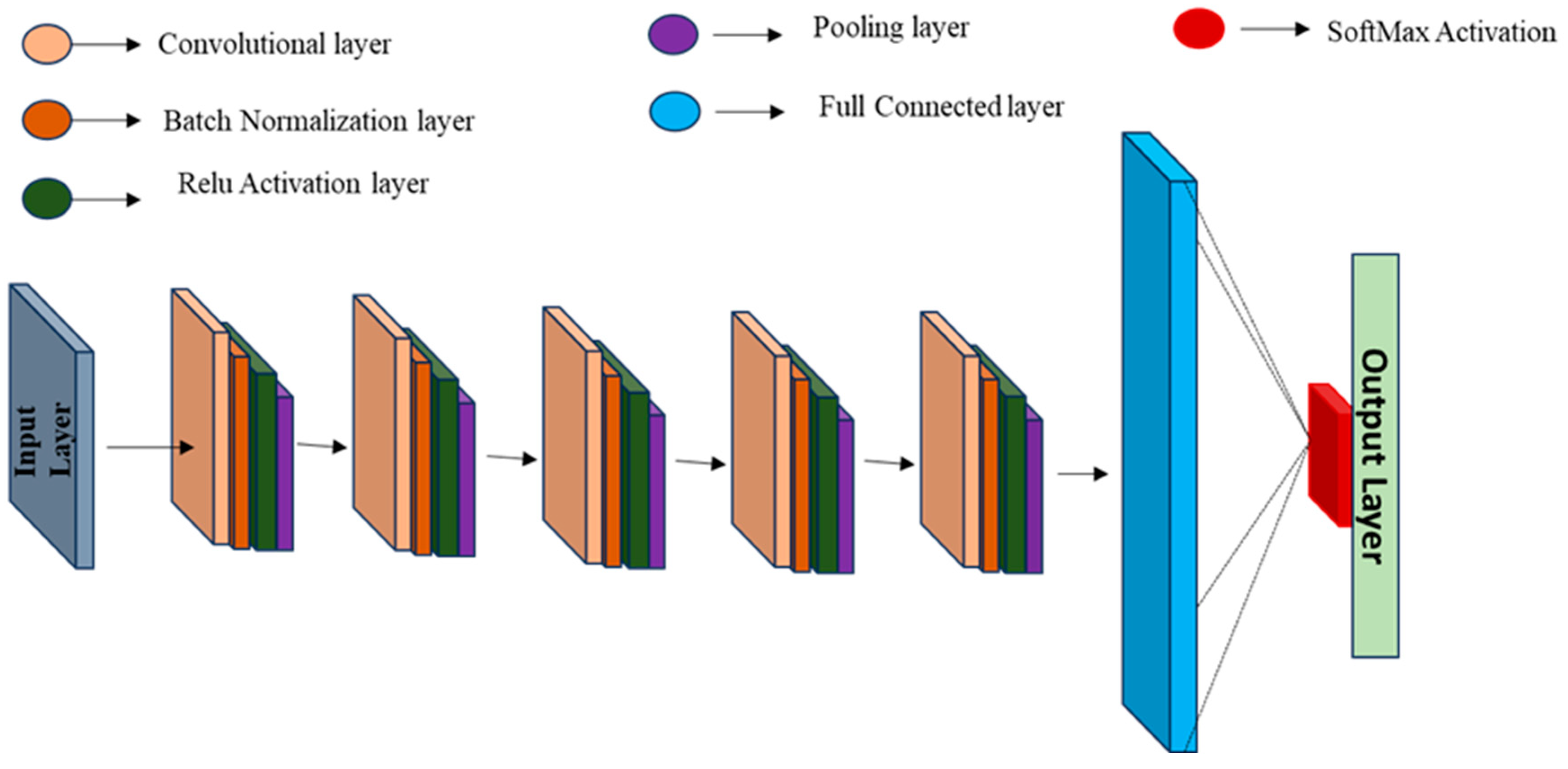
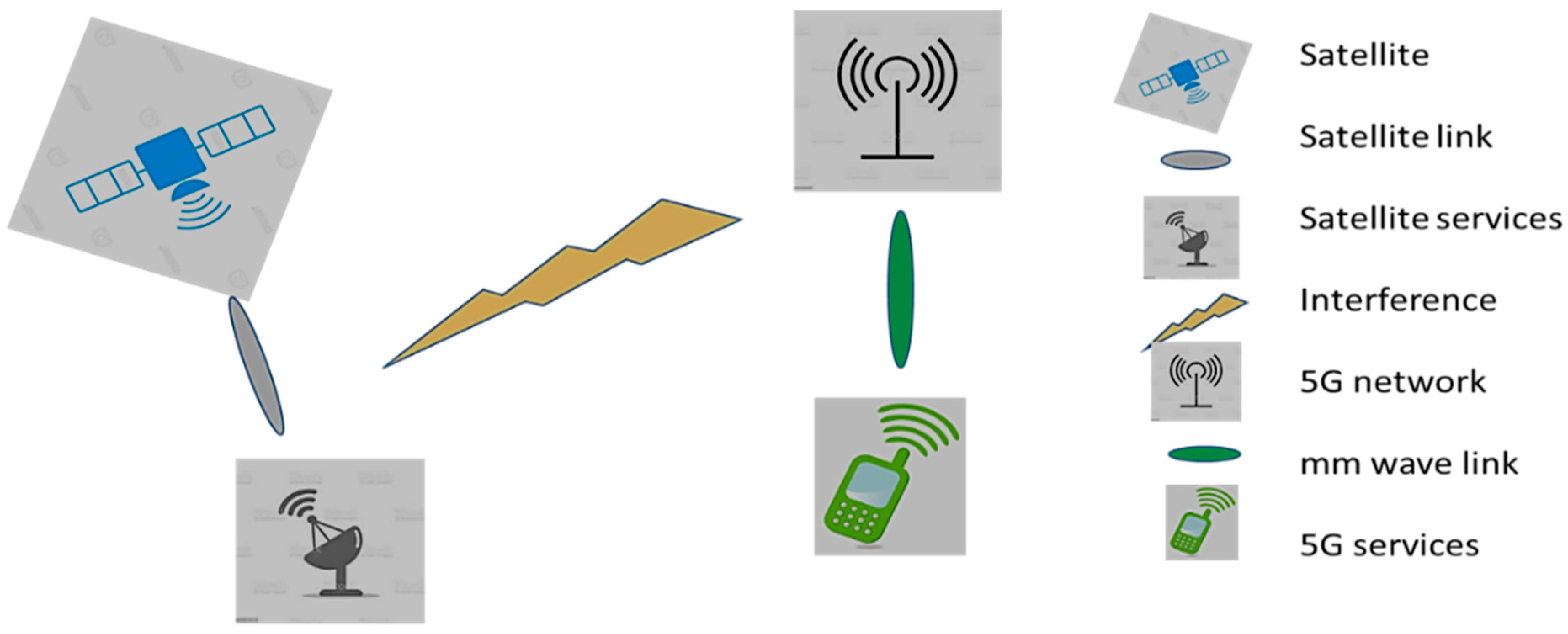

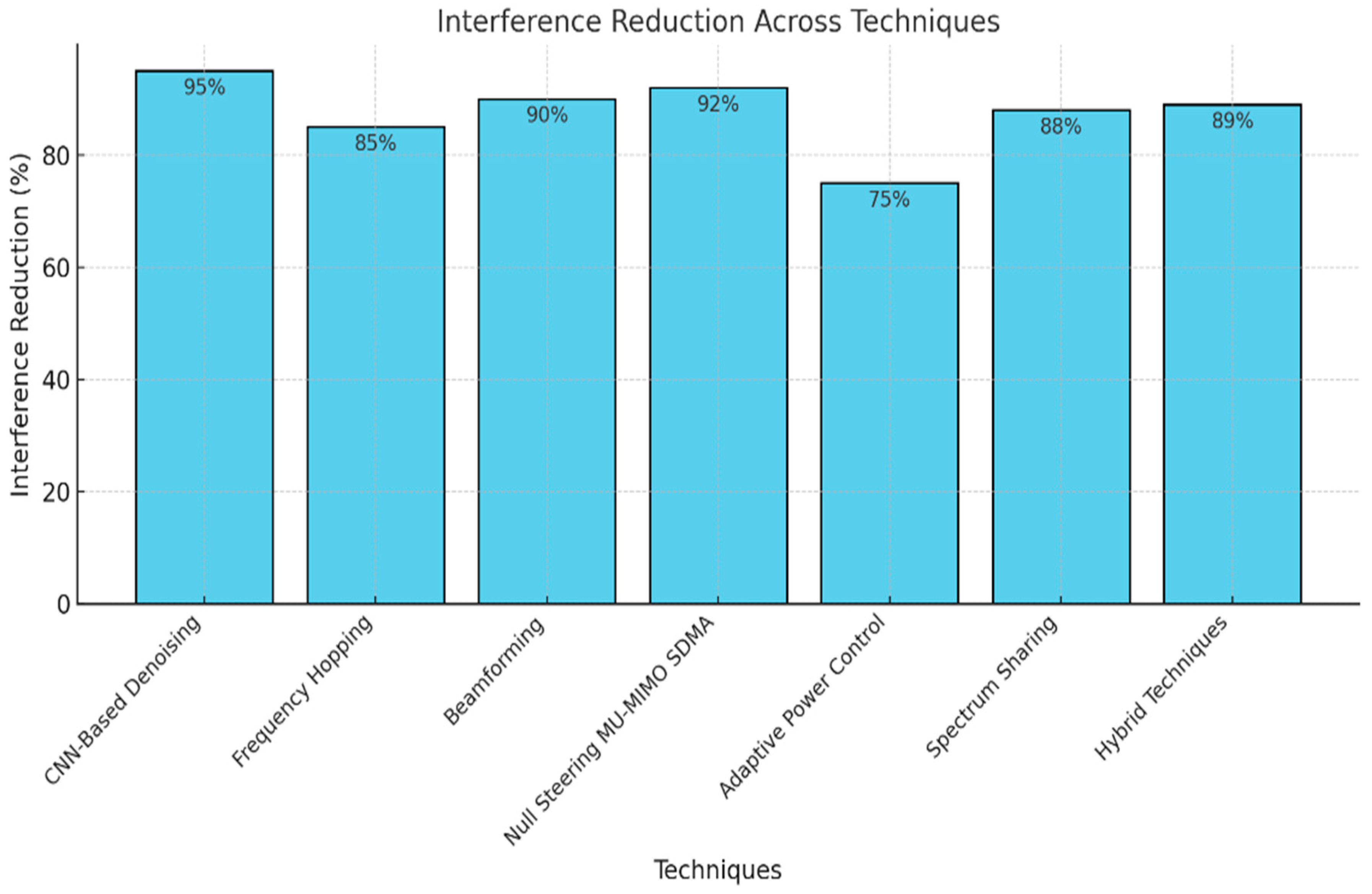
| Coexistence | References |
|---|---|
| Coexistence of 5G system and fixed satellite service | [8,71,72,79,80,81,82,83,84,85] |
| Coexistence of radar and communication systems | [59,63,64,65,66,86,87,88,89,90] |
| Coexistence of terrestrial and satellite services | [75,76,77,78,91] |
| Proposed Technique/Algorithm | Advantages | Limitations | References |
|---|---|---|---|
| Deep interference mitigation and denoise real-world FMCW radar signals | CNN was used | To evaluate and optimize based on real data | [9] |
| Co-channel coexistence analysis between 5G IOT system and fixed satellite service at 40 GHz | Parameters considered are height of station, distance, and antenna patterns | Specific to high frequency of 40 GHz | [18] |
| Interference mitigation using adaptive beamforming with the RLS algorithm | Minimum distance to mitigate the interference | Only the distance parameter is considered | [72] |
| Spread spectrum | Distributes signals across a wider frequency band to minimize interference impact | May require additional bandwidth and resources | [84] |
| Beamforming | Creates a focused signal in a specific direction using multiple antennas | Requires advanced hardware and spatial processing capabilities | [85] |
| Frequency hopping | Mitigates interference by rapidly switching frequencies | Susceptible to frequency hopping jammers | [100] |
| Interference mitigation via relaying | A relay channel with correlation is used | Requires a large number of antennas, assumes optimal quantization noise covariance, may not be practical. | [101] |
| BICM OFDM system | Minimize interference using a bit-interleaved coded system | Effective in the absence of narrowband interference | [103] |
| Spectrum sharing | Explore spectrum sharing techniques for multiple systems | May require complex interference management schemes | [104] |
| Hybrid techniques | Combine Maximum Likelihood Estimation and self-cancellation | Results are dependent on modulation and data rates | [105] |
| Null steering MU-MIMO SDMA | Employs null steering MU-MIMO SDMA for interference mitigation | Requires knowledge of victim FSS ES direction angles | [106] |
| Highly selective filter for suppressing interference of 5G signals at C-band satellite receiver | Filters are used to provide less loss | Parameters are not considered | [109] |
Disclaimer/Publisher’s Note: The statements, opinions and data contained in all publications are solely those of the individual author(s) and contributor(s) and not of MDPI and/or the editor(s). MDPI and/or the editor(s) disclaim responsibility for any injury to people or property resulting from any ideas, methods, instructions or products referred to in the content. |
© 2025 by the authors. Licensee MDPI, Basel, Switzerland. This article is an open access article distributed under the terms and conditions of the Creative Commons Attribution (CC BY) license (https://creativecommons.org/licenses/by/4.0/).
Share and Cite
Parveen, N.; Abdullah, K.; Badron, K.; Javed, Y.; Khan, Z.I. Coexistence in Wireless Networks: Challenges and Opportunities. Telecom 2025, 6, 23. https://doi.org/10.3390/telecom6020023
Parveen N, Abdullah K, Badron K, Javed Y, Khan ZI. Coexistence in Wireless Networks: Challenges and Opportunities. Telecom. 2025; 6(2):23. https://doi.org/10.3390/telecom6020023
Chicago/Turabian StyleParveen, Nagma, Khaizuran Abdullah, Khairayu Badron, Yasir Javed, and Zafar Iqbal Khan. 2025. "Coexistence in Wireless Networks: Challenges and Opportunities" Telecom 6, no. 2: 23. https://doi.org/10.3390/telecom6020023
APA StyleParveen, N., Abdullah, K., Badron, K., Javed, Y., & Khan, Z. I. (2025). Coexistence in Wireless Networks: Challenges and Opportunities. Telecom, 6(2), 23. https://doi.org/10.3390/telecom6020023







